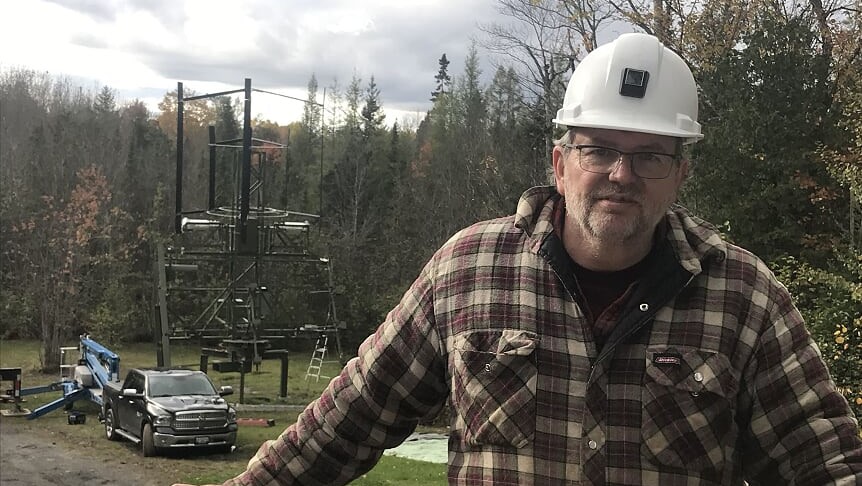
Solar Wind Reliance Initiatives: combining wind and solar for powerful renewables
As we navigate a global pandemic and a just recovery, we want to amplify the stories of those who are working towards a low-carbon future, like Solar Wind Reliance Initiatives (SWRI). To build a vibrant low-carbon economy, we’ll need innovative tech that supports our needs while preserving the environment. That’s why Bullfrog Power is sponsoring the Centre for Social Innovation’s Earth Tech, an accelerator for startups and nonprofits working on climate and freshwater solutions.
 Wind and solar energy have dominated the renewable energy market this past decade, capturing more than 90% of renewable infrastructure investment. Ross Armstrong wondered why no one was working on a solution that combined the two technologies. The synergy of this approach is that wind typically peaks when solar is at a minimum, and vice versa. By combining the two energy inputs, energy delivery is more consistent and, in off-grid situations, storage needs could be reduced by as much as 70%.
Wind and solar energy have dominated the renewable energy market this past decade, capturing more than 90% of renewable infrastructure investment. Ross Armstrong wondered why no one was working on a solution that combined the two technologies. The synergy of this approach is that wind typically peaks when solar is at a minimum, and vice versa. By combining the two energy inputs, energy delivery is more consistent and, in off-grid situations, storage needs could be reduced by as much as 70%.
Ross founded Solar Wind Reliance Initiatives Ltd (SWRI) with the goal of combining wind and solar to provide affordable and reliable renewable energy to rural, remote, and Indigenous communities. He noted that 1.3 billion people worldwide don’t have access to electricity. In Canada alone, more than 270 communities rely primarily on electricity from diesel-powered generators.
“This lack of affordable electricity access can often be traced back to the high cost of building transmission infrastructure in remote areas,” Ross said. “SWRI’s mobile, scalable platform aims to eliminate that cost and bring energy independence to remote communities around the world.”
Catching the breeze
SWRI is currently finalizing their full-size pilot model. They’re completing electrical field installation, as well as anticipating ESA approval in December and Hydro One net-metering connection shortly. Ross said, “It’s been a tremendous learning process getting the technology to its current state.”
Ross’s next stage is to secure financing for commercialization and product marketing, and he’s ready to meet that challenge head on. “Globally, the world is not meeting the Paris climate targets in the appropriate timeframe,” he said. “We need to adapt and implement new innovations in order to overcome this global crisis.”
Picking up speed
Through Earth Tech, SWRI was introduced to the Helsinki Energy Challenge, a global search for sustainable city heating solutions. “During this competition, we began to rethink and pivot our business model,” Ross said. “We went from being a renewable electricity provider to one that also provides a renewable energy heating solution. We are anticipating that our product will include both solar and wind power heating elements.” This could help SWRI’s customers avoid emissions from natural gas and, in the case of Helsinki, coal-based heating.
SWRI has also been improving their solar design approach in order to meet the needs of the Canadian marketplace. They have incorporated snow sensor technology in order to avoid snow accumulation on solar collectors. Also, instead of having a solid wall of solar collectors that can create high wind shear forces, SWRI rotates individual rows of collectors to mitigate this operating risk. Their solar energy approach can work with both concentrated solar design elements as well as photovoltaic solar elements.
“There is a clear need for the energy independence that combined wind and solar can bring.”
Ross Armstrong
For Canadian markets, SWRI pursues a dual-axis tracking solar methodology that enables their solar panels to directly face the sun as it moves throughout the day. Studies have shown that this approach is the lowest-cost solar option for northern climates. For example, data suggest that a dual-axis tracking solution in Canada’s northernmost community (Alert, Nunavut), could achieve 97% of the solar energy of an equivalent fixed-axis solution in Canada’s sunniest location (Lethbridge, Alberta).
Offering energy independence
With these improvements in design, Ross hopes to offer a better energy solution for Indigenous and remote communities. “These communities have year-round energy needs, but the primary solution that is offered to them, solar, is a seasonal one,” Ross explained. “Our solution offers more year-round power that matches their needs, which significantly lowers the cost of expensive battery storage when supply doesn’t meet demand.”
Ross also noted that some Indigenous communities SWRI has connected with have large hydro-electric dam facilities operating on their land. “Despite this, their local power needs are not being met by the hydro-electric companies operating on their own land,” Ross said. “There is a clear need for the energy independence that combined wind and solar can bring.”
Curious about other Earth Tech ventures? See how Springbay Studio is using environmental games to inspire young learners.
